 Mid-11th C. mural, Mirozhsky Monastery in Pskov
Mid-11th C. mural, Mirozhsky Monastery in Pskov
The Ascension of the Lord is one of the twelve great feasts of the Orthodox Church.
Christian feasts are like rings on a golden chain, inextricably linked to one other. Forty days after Pascha comes the feast of the Ascension. Ten days after the Ascension is the feast of Pentecost.
Before speaking about the Ascension, we should focus on the question of the importance and meaning of Biblical and church symbolism, of the connection of sacred history with Church liturgics. To participate in a religious feast is not just to remember the events of sacred history, but to be mystically involved in them, to spiritually experience them.
Through the Church services, their images and rituals, their symbolic rites, a man becomes a real participant in the events that took place in world history and are repeated in the rhythms of the Church calendar. The Ascension of the Lord is the end of the earthly life of Christ the Savior, shining with a dazzling light. The Ascension is the crown of the Christian feasts. It is the visible form of the return of the Son of God to His pre-eternal existence. It is the revelation before man of the infinite expanse of spiritual perfection.
In his earthly life, Christ subjected Himself to time and history, and at the same time, He stands above time and history, inasmuch as He is their Creator and Lord. For a Christian, the life of Christ of Nazareth is not the past, something that has gone by, but the immediate present and the infinite future. A Christian feast is the touching point of the eternal with the temporal, the earthly with the Heavenly; it is the revelation of the spiritual aeon on earth in the sacred space of a church.
The Ascension of Christ has an ontological, moral, spiritual, and eschatological significance. The Gospel of Mark gives a majestic picture of the Ascension of Jesus Christ. But it is not enough to have and read the Gospel. We also need to know its special language, symbolism, and other means of representation. This does not mean that Gospel symbolism turns events into an abstract allegory. No, the Gospel is true, but it is multifaceted and multidimensional. In the earthly, the Heavenly is present, and in the historical—the eternal. A symbol does not replace but rather deepens the meaning and reveals the sacred plan of events.
The Gospel is the revelation of the Divine mind through the human word; the revelation of the spiritual world, of eternal life, of the union of the human soul with the Divine, of the highest realities of existence, beyond the bounds of phenomenology, of what cannot be subject to sensory perception or logical analysis. It is perceived by the soul only through mystical participation, through intuitive penetration into the world of spiritual entities, into the world of the Divine energies, into the world of super-logical categories. Therefore, the Sacred Scriptures use symbols that should elevate the mind from the familiar and customary to the unknown and mysterious, from the visible to the invisible.
The Biblical symbol is a spiritual link between the intellectual ability of man and the abyss of Divine gnosis. When we take the Bible in hand, we are faced with a great mystery. You can only come into contact with this mystery through reverence for it.
Forty days passed from Pascha to the Ascension. The Lord abode with His disciples for forty days, teaching them the mysteries of the Heavenly Kingdom. Before the Resurrection of Christ, these mysteries would have been incomprehensible and inaccessible to them.
The number forty symbolizes the time of spiritual trial and earthly life. For forty years, Moses led the people through the desert to the Promised Land. Jesus Christ fasted for forty days before His Gospel preaching. He remained on earth for forty days after His Resurrection, appearing to His disciples and apostles, preparing them to receive Divine grace and for the future preaching of the Gospel.
The apostolic preaching can be represented as three concentric circles, three stages with increasing exertion:
- The preaching of the apostles to their fellow countrymen during the earthly life of Christ the Savior;
- Between Christ’s Resurrection and His Ascension—the mission to all of Palestine, which required more spiritual preparation and self-sacrifice;
- The global preaching of the apostles after the descent of the Holy Spirit—the preaching which nearly all of them finished with a martyric death.
On the fortieth day after the Resurrection, the Lord, surrounded by His disciples, left Jerusalem and headed for the Mount of Olives. In His farewell conversation, He spoke of the miraculous power a man receives from faith. Some wonder why the wonderful signs of faith that Christ spoke about do not clearly manifest now.
There are different degrees of faith:
- Faith that allows for possibility and probability. This is the faith of rationalists with suppressed and muffled religious feeling. It is like the twinkling luster of stars that do not light up the night.
- Another degree of faith when a man believes but his heart is not warmed by love. This is like the cold and dead light of the moon.
- Finally, there is that faith that includes within itself and unites the mind, senses, and will of man, which becomes the chief need of the soul, the goal and content of his life, the unceasing burning of his heart. Such faith is like the light of the sun, whose rays bring warmth and life. Such faith is a podvig of the soul. Such faith is miraculous and victorious.
The Gospel tells us about the Ascension of Christ into Heaven. Heaven is used in three ways in the Sacred Scriptures:
- The atmosphere around the earth—what we perceive as a great blue ocean in which our earth floats like a ship.
- Outer space—a view of the vast starry sky that inspired and thrilled not only poets, but also philosophers and great scientists. “Two things amaze me: the starry sky above me and the moral law within me,” wrote Kant. When the soviet astronaut Yuri Gagarin was asked upon returning from his flight into space if he had seen God in space, he said no. His response delighted the anti-religious primitivists. Gagarin did not understand, or rather did not want to understand that his flight into space was movement within physical space, within the “kingdom of matter,” having nothing to do with the spiritual world.
- The immaterial spiritual sphere, which is not conceived of in physical categories or dimensions. It is a different plane of existence. However, this sphere is not the anti-world, the antimatter hypothetically allowed for by science, but the aeon of eternity. In the system of sacred Biblical signs and images, the visible heavens can only serve as a symbol of the spiritual Heaven. This is how it appeared in the Ascension event—an event that is both historically and mystically real.
The Ascension of Christ the Savior has ontological significance. The Son of God took on human nature, which entered into Divine glory in the Ascension. The Ascension has an eschatological meaning. It was the end of Christ’s earthly life, and the Second Coming will be the end of the cycle of mankind’s earthly existence. The Ascension has a moral significance for us. We must remember that we belong not only to the earth, but to Heaven; not only to time, but to eternity; not only to matter, but to spirit. And living on earth, we must try to raise our thoughts and heart above all that is base, rude, and sinful. Speaking of the Ascension of Christ, the Evangelist Mark introduced a symbolic image: Jesus Christ sat down on the right hand of God the Father. God is outside of time and space. What does this allegory, this anthropomorphic metaphor mean? When the emperor would choose a co-regent, or his son-heir reached adulthood, then the special ritual of the enthronement was performed. Two thrones were placed side by side in the palace hall. On one sat the emperor, and to the other was led the co-regent, sitting on the right hand of the emperor. This signified that they had the same dignity and power.
This symbolic image further emphasizes the axiological significance of the Ascension. In the person of the God-Man Christ the Savior, all of mankind has received the possibility of infinite spiritual ascent.
Jesus Christ ascended with hands stretched forth in blessing. The apostles and disciples, standing at the Mount of Olives, represented the first Christian Church. This image, full of love and hope, is a sign and promise that the blessing of God will always abide in the Church and will preserve it forever.



